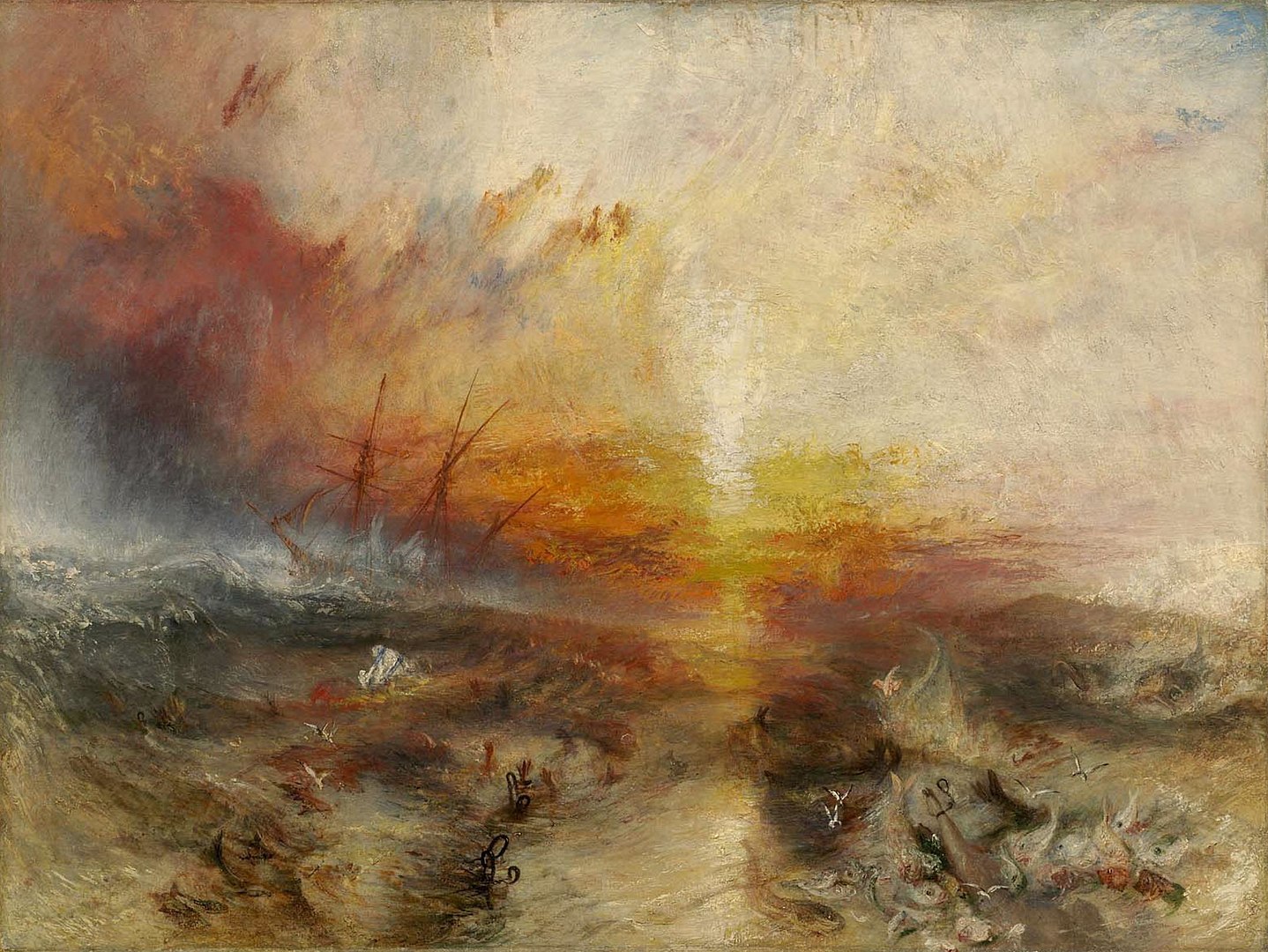
A Story of Beauty, Horror and Artistic Revolution
In the hazy red dusk of a storm-churned sea, a monstrous wave rises to swallow the sun. Foaming water gleams with iridescent shades of orange and crimson, while dark, writhing shapes twist beneath the surface. Chains float in the surf. A severed limb pokes grotesquely from the water, gripped by the jaws of a sea creature. Above, a majestic ship sails away into the horizon, its sails illuminated by the golden light, as if indifferent to the chaos it leaves behind.
This is The Slave Ship, one of the most arresting and controversial paintings of the 19th century, created by the English Romantic master Joseph Mallord William Turner in 1840.
While its beauty might first captivate the viewer, a closer look reveals a chilling tale of human cruelty and an artist’s cry for justice. The painting is not just a visual symphony of color and movement , it is a political statement, a historical commentary, and a masterpiece of evolving artistic sensibilities.
The Scene Beneath the Surface: What Does The Slave Ship Mean?
At first glance, The Slave Ship seems almost abstract , a swirl of colors evoking emotion more than narrative. But the horror is there, buried beneath its stunning surface. The painting’s true meaning lies in its depiction of a brutal historical event: the murder of enslaved people thrown overboard for profit.
The specific inspiration came from the Zong massacre of 1781, when the crew of the British slave ship Zong deliberately drowned 132 enslaved Africans to collect insurance. According to maritime law at the time, the loss of cargo (enslaved people, seen as property) due to “natural causes” like illness was not covered by insurance, but jettisoned cargo during a storm was. The act was both premeditated and grotesque , a horrifying reflection of the commodification of human life during the transatlantic slave trade.
Turner, a passionate opponent of slavery, was deeply moved by the story. He used this painting to protest the practice, unveiling it at the 1840 meeting of the British Anti-Slavery Society. Though slavery had been abolished in the British Empire seven years earlier, it persisted in the Americas and the painting served as a rallying cry against its continued existence.
Rather than illustrating the event with photographic realism, Turner chose to evoke it through emotional intensity. The result is a painting that does not simply show tragedy , it makes us feel it.
A Storm of Emotion: The Artistic Style of The Slave Ship
Turner’s The Slave Ship is one of the most powerful examples of Romanticism, an art movement that prized emotion, nature, and the sublime over reason and order. But Turner was also ahead of his time , his brushwork, use of light, and abstracted forms verge on Impressionism, even though the movement would not emerge until decades later in France.
Color as Emotion
The painting is dominated by a terrifying palette of reds, oranges, and deep blues. The sky is not merely a background , it is a participant in the scene. Nature itself seems enraged, responding to the horror enacted by humankind. The sea rises in revolt. The sun, blood-red, is setting not just on the day, but on an era of unimaginable suffering.
Turner masterfully uses color and light not just to represent a setting, but to evoke visceral feeling. This technique, revolutionary at the time, influenced generations of artists including Claude Monet and the later American abstract expressionists.
Brushwork and Form
The painting eschews clear outlines and detailed figures. Instead, it is a maelstrom of movement. This was a deliberate choice. Turner believed that raw brushstrokes could better convey the emotional truth of a scene than cold, calculated realism. The indistinct forms in the sea , human limbs, sea creatures, chains , are as much symbolic as literal.
This hazy abstraction shocked some of Turner’s contemporaries. But for Turner, the technique was essential to conveying the spiritual and emotional magnitude of what he was depicting.
The Story Behind the Canvas: Why Did Turner Paint This?
To understand The Slave Ship, one must understand Turner , a man ahead of his time, a visionary who saw the power of art to shape public consciousness.
Born in 1775 in London, J.M.W. Turner rose from humble beginnings to become one of Britain’s most celebrated painters. Obsessed with light, weather, and the destructive power of nature, he frequently traveled to study storms and sunsets firsthand. But Turner was not just a landscape painter , he was a moralist.
Turner read extensively. In 1840, he encountered The History and Abolition of the Slave Trade by Thomas Clarkson, a leading abolitionist. The account of the Zong massacre deeply disturbed him. Around the same time, he was preparing to attend the World Anti-Slavery Convention in London.
In response, he painted The Slave Ship not as a commission, but as a statement. He even added a poetic inscription from his own unfinished poem, “Fallacies of Hope”, to the catalogue entry:
“Hope, Hope, fallacious Hope!
Where is thy market now?”
The line is devastating. Turner challenges the very idea that there is any redemption to be found in a world where such horrors are possible.
From Controversy to Canon
When The Slave Ship debuted at the Royal Academy in 1840, it was met with mixed reactions. Some critics were overwhelmed by its emotive power, others were baffled by its lack of traditional form. Even Turner’s friend and biographer, John Ruskin, initially struggled to understand it.
But over time, the painting gained recognition as a pioneering work , both politically and artistically. Today, it is considered one of the most important paintings in the history of Western art.
American writer and philosopher Henry David Thoreau once wrote about the painting: “It was like a storm in the distance – it was like the universe holding its breath.” The quote captures the spiritual weight of the piece , it is not just about the Zong massacre, but about all injustice, all cruelty, all the failures of human morality under the guise of civilization.
Where Is The Slave Ship Now?
After Turner’s death in 1851, The Slave Ship passed through various hands before being acquired by Boston industrialist and collector James Thomas Fields, and later John Taylor Johnston, the founding president of the Metropolitan Museum of Art in New York.
Eventually, the painting was purchased by the renowned American art collector Alice Hooper, who donated it to the Museum of Fine Arts, Boston, where it remains today.
The painting is part of the museum’s permanent collection and is on display as a centerpiece of its European art galleries. Standing before it, visitors are often struck by its beauty , and then haunted by its truth.
Turner’s Enduring Message: Why The Slave Ship Still Matters
In a world still grappling with the legacies of colonialism, racism, and exploitation, The Slave Ship is more than a historical artifact. It is a mirror. Turner compels us not only to reckon with a brutal past, but to question how injustice manifests in our present.
The painting speaks to the power of art as protest, as moral inquiry, as spiritual warning. Turner chose not to document the Zong massacre in cold detail, but to show us what it felt like , the fear, the chaos, the fury of a storm both literal and metaphorical.
And while the ship sails off toward the blood-red sun, the sea does not forget. The chains and limbs, the cries of the dying, remain just beneath the surface.
Turner leaves us with a warning: if we look away from the suffering of others, we too may one day sail into a storm of our own making.
J.M.W. Turner’s The Slave Ship is a rare fusion of artistic genius and moral clarity. At once a breathtaking work of Romantic expressionism and a searing indictment of slavery, it remains as emotionally potent today as when it first shocked viewers in 1840.
Its legacy lives not only in art history but in the broader narrative of human rights and social justice. Turner proved that painting could be more than beautiful , it could be truthful, courageous, and even revolutionary.
By confronting viewers with both the sublime and the savage, Turner demands that we never forget what happened beneath the waves , and never stop striving to rise above it.




